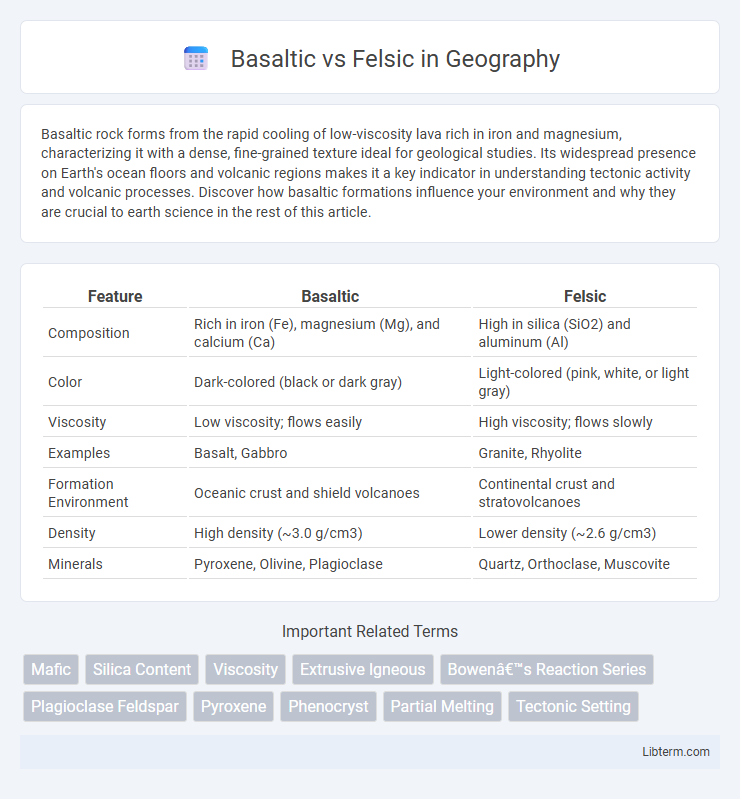Basaltic rock forms from the rapid cooling of low-viscosity lava rich in iron and magnesium, characterizing it with a dense, fine-grained texture ideal for geological studies. Its widespread presence on Earth's ocean floors and volcanic regions makes it a key indicator in understanding tectonic activity and volcanic processes. Discover how basaltic formations influence your environment and why they are crucial to earth science in the rest of this article.
Table of Comparison
| Feature | Basaltic | Felsic |
|---|---|---|
| Composition | Rich in iron (Fe), magnesium (Mg), and calcium (Ca) | High in silica (SiO2) and aluminum (Al) |
| Color | Dark-colored (black or dark gray) | Light-colored (pink, white, or light gray) |
| Viscosity | Low viscosity; flows easily | High viscosity; flows slowly |
| Examples | Basalt, Gabbro | Granite, Rhyolite |
| Formation Environment | Oceanic crust and shield volcanoes | Continental crust and stratovolcanoes |
| Density | High density (~3.0 g/cm3) | Lower density (~2.6 g/cm3) |
| Minerals | Pyroxene, Olivine, Plagioclase | Quartz, Orthoclase, Muscovite |
Understanding Basaltic and Felsic Rocks
Basaltic rocks are mafic, rich in iron and magnesium, and typically dark-colored with high density, forming from low silica magma that cools rapidly. Felsic rocks contain high silica content, lighter in color, less dense, and originate from magma rich in aluminum and potassium, resulting in slower cooling and larger crystals. Understanding the mineral composition and formation environment of basaltic and felsic rocks provides crucial insights into volcanic activity and the Earth's crustal formation processes.
Composition and Mineral Content
Basaltic rocks are enriched with mafic minerals such as pyroxene and olivine, containing high levels of iron, magnesium, and calcium, resulting in a dense, dark composition. Felsic rocks, composed primarily of quartz, feldspar, and mica, exhibit higher concentrations of silica and aluminum, contributing to their lighter color and lower density. The mineral content variation directly influences the physical properties and formation environments of basaltic and felsic rocks.
Color and Appearance Differences
Basaltic rocks are typically dark-colored, ranging from black to dark gray, due to their high magnesium and iron content, giving them a dense and fine-grained appearance. Felsic rocks, in contrast, exhibit lighter colors such as white, pink, or light gray because of their high silica and aluminum content, resulting in a coarse-grained texture with visible mineral crystals like quartz and feldspar. These color and texture differences serve as key identifiers in distinguishing between mafic basaltic and felsic igneous rocks.
Formation and Geological Processes
Basaltic rocks form from the rapid cooling of low-viscosity magma rich in magnesium and iron, typically at divergent plate boundaries or oceanic hotspots. Felsic rocks crystallize more slowly from high-viscosity magma enriched in silica, potassium, and aluminum, usually in continental crust settings or convergent plate boundaries. The contrasting cooling rates and chemical compositions influence their mineralogy and textures, driving distinct geological processes such as oceanic crust formation for basalt and continental crust development for felsic rocks.
Texture and Crystal Size
Basaltic rocks typically exhibit a fine-grained or aphanitic texture with small, often microscopic crystals due to rapid cooling of mafic magma at the surface. In contrast, felsic rocks commonly display a coarse-grained or phaneritic texture, characterized by larger, visible crystals formed from slower cooling of silica-rich magma beneath the Earth's surface. The crystal size difference directly reflects the cooling history and chemical composition, with basaltic rocks having smaller crystals and felsic rocks showing significantly larger mineral grains.
Volcanic Activity and Lava Types
Basaltic volcanic activity is characterized by low-viscosity lava that flows easily, resulting in broad shield volcanoes and extensive lava fields formed from mafic, iron- and magnesium-rich magma. Felsic volcanic activity produces high-viscosity lava due to silica-rich magma, leading to explosive eruptions and the creation of stratovolcanoes with thick, slow-moving lava domes. The differences in viscosity and gas content between basaltic and felsic lavas directly influence eruption style, lava flow length, and volcanic landform development.
Density and Weight Comparison
Basaltic rocks have a higher density, typically ranging from 2.9 to 3.1 g/cm3, due to their mafic mineral content rich in iron and magnesium compared to felsic rocks, which usually range from 2.6 to 2.7 g/cm3. This density difference results in basaltic rocks being heavier per unit volume than felsic rocks like granite and rhyolite. The greater density in basaltic rocks influences geological processes, such as crustal formation and mantle convection dynamics.
Distribution in Earth's Crust
Basaltic rocks predominantly compose the oceanic crust, covering roughly 70% of the Earth's surface and forming the dense, thin layers beneath the oceans. Felsic rocks, rich in silica and lighter minerals, primarily make up the continental crust, contributing to its thicker, less dense composition. The contrasting distribution influences tectonic activity, with basaltic crust involved in mid-ocean ridges and felsic crust shaping continental mountain ranges.
Common Examples and Locations
Basaltic rocks commonly form in oceanic crust regions such as the mid-Atlantic Ridge and Hawaiian Islands, with basalt being a key example characterized by its dark color and fine-grained texture. Felsic rocks, like granite and rhyolite, predominantly occur in continental crust areas including the Sierra Nevada Mountains and the Andes, known for their lighter color and high silica content. These differences in mineral composition and formation environment significantly influence their geological distribution and appearance.
Significance in Geology and Industry
Basaltic rocks, rich in iron and magnesium, dominate oceanic crust and are crucial for understanding plate tectonics and volcanic activity. Felsic rocks, high in silica and aluminum, form continental crust and are valued in the construction and ceramics industries due to their durability and aesthetic properties. Both rock types influence mineral resource distribution, impacting mining and geological exploration strategies.
Basaltic Infographic

 libterm.com
libterm.com